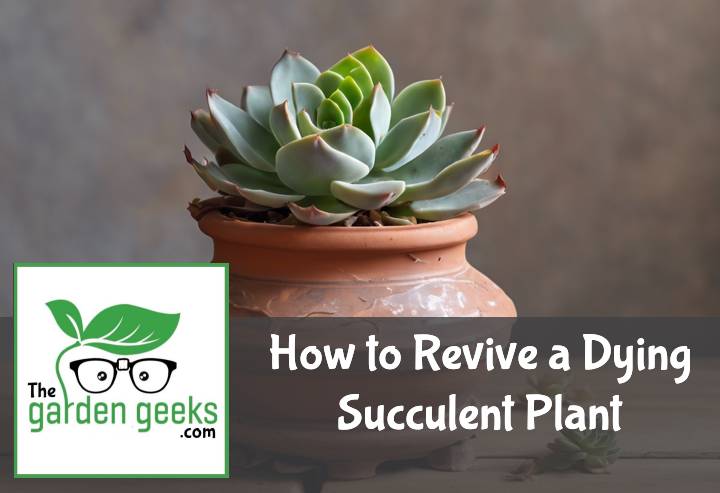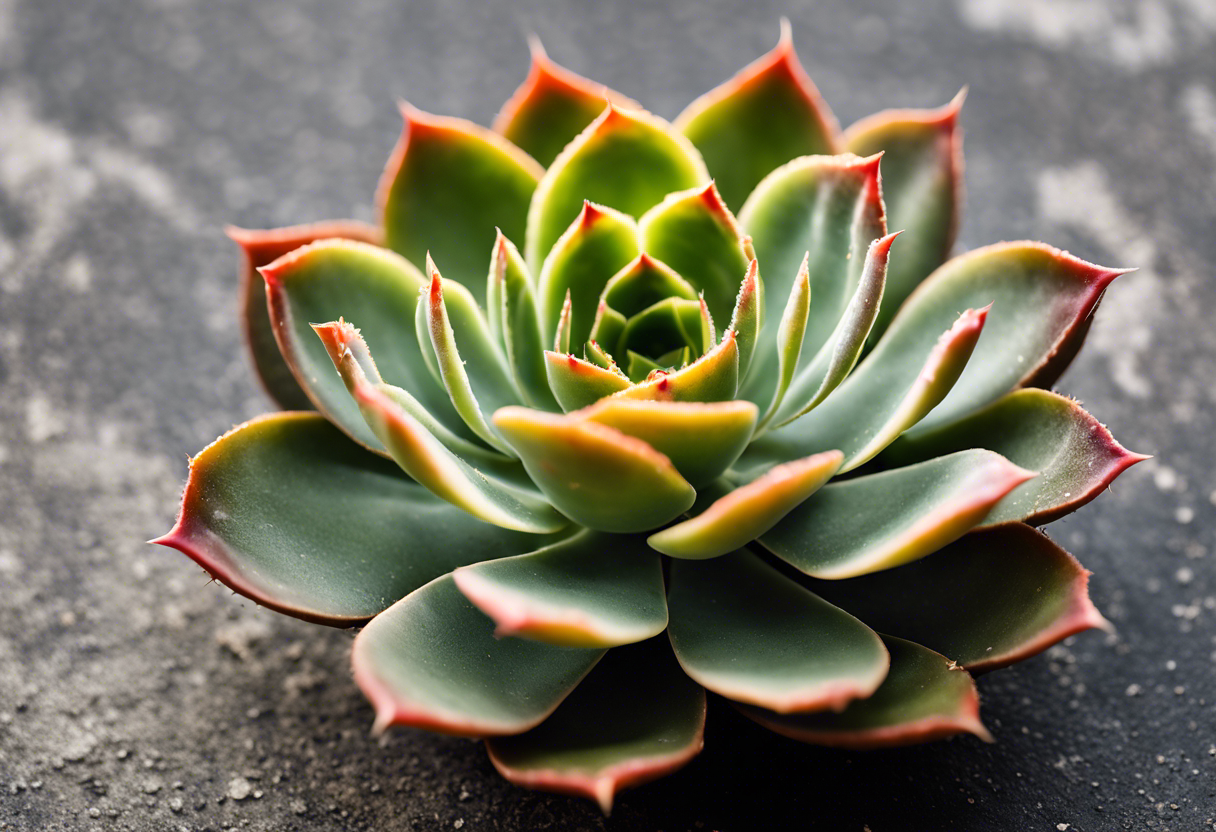Ever looked at your once vibrant, plump succulent only to find it wilted and lifeless? We’ve all been there. It’s like a scene from a plant horror movie! But don’t worry, there’s hope yet. With the right care, you can bring your dying succulent back to life. How to Revive a Dying Succulent Plant isn’t as complicated as it sounds.
In this blog post, we’ll guide you through the process of identifying what’s going wrong with your succulent and how to fix it. So grab your gardening gloves and let’s get plant doctoring! Keep reading about How to Revive a Dying Succulent Plant.
Key Takeaways
- Identify signs of a dying succulent: discoloration, drooping, or overwatering symptoms.
- Stop watering immediately if the plant is overwatered. Let it dry out completely.
- Remove the succulent from its pot and trim off any rotten roots.
- Repot the plant in fresh, well-draining soil and a new pot if necessary.
- Water sparingly until the plant recovers. Provide adequate sunlight but avoid direct harsh light.
- Consider using a special succulent fertilizer for added nutrients.
Understanding Succulent Plants
Alright, let’s get down to the nitty-gritty of succulent plants. These little green guys are pretty popular, but they can be a bit tricky to care for. And if you’re not careful, you might end up with a dying succulent on your hands.
What are Succulent Plants?
So, what exactly are these succulents we’re talking about? Well, they’re a type of plant that stores water in their leaves or stems. This makes them super tough and able to survive in dry conditions. There’s a whole bunch of different varieties of succulents, from the spiky Aloe Vera to the cute and chubby Echeveria.
But don’t let their hardy nature fool you! While they might look like they can take anything you throw at them, succulents do have their limits. And that’s where understanding the basics of succulent care comes into play.
Why Do Succulents Die?
Now onto the sad part – why do these little guys sometimes kick the bucket? One common culprit is overwatering succulents. It’s easy to think that more water equals more love, but too much H2O can actually drown your plant and cause root rot.
Another common mistake is not giving your succulent enough sunlight. These plants love basking in bright light! If they don’t get enough rays, they can become weak and start wilting.
So there you have it – overwatering and lack of sunlight are two major reasons why your succulent might be looking a bit under the weather. But don’t worry! We’ll cover how to revive a dying succulent plant later on in this post. Stay tuned!
Identifying Signs of a Dying Succulent
Alright, let’s get down to the nitty-gritty. When it comes to how to revive a dying succulent plant, the first step is recognizing that your green buddy is in distress. We’re talking about dying succulent signs and succulent health indicators here.
Overwatering Symptoms
Now, you might think giving your plant a good drink is always a good idea, but hold up! Too much H2O can lead to some serious issues. If your succulent has squishy, yellow leaves or if there’s black stem rot going on, you’ve got yourself an overwatered plant. These are classic overwatered succulent symptoms.
But don’t confuse this with other problems. Overwatering can mimic other issues like pest infestations or sunburn, so keep an eye out for these specific signs when diagnosing overwatered succulents.
Underwatering Symptoms
On the flip side, not enough water can also spell trouble for your leafy friend. If your plant’s leaves are wrinkled or shriveled and it seems like they’re just not perking up no matter what you do, it could be underwatered.
These are telltale underwatered succulent signs, and they’re different from other issues like too much sunlight or pests. So make sure you’re recognizing underwatering when diagnosing dehydrated plants.
Sunburn and Insufficient Light Symptoms
Let’s talk about light now. Just like Goldilocks, your succulents want their light “just right.” Too much sunlight can cause sunburn (yes, plants can get sunburn too!). Look for white or brown scorch marks on the leaves – those are classic succulent sunburn signs.
On the other hand, if your plant isn’t getting enough light, it might start to stretch out or lose its vibrant color. These are signs of light deficiency in plants. So remember, balance is key when it comes to lighting!
Pest Infestation Symptoms
Finally, let’s talk about those pesky pests. If you notice small holes in your plant’s leaves or a sticky residue on the surface, you might have a pest problem.
These succulent pest infestation signs can be easy to miss if you’re not looking closely. But don’t worry – once you know what to look for, diagnosing plant pest problems becomes a whole lot easier!
Steps to Revive a Dying Succulent Plant
Reviving a dying succulent plant can be a bit of a challenge, but with the right approach, you can bring your green buddy back to life. Let’s dive into the nitty-gritty of succulent revival steps and healthy succulent maintenance.
Assessing the Damage
First things first, you need to play detective and assess the damage. Look for succulent damage signs, like discolored leaves or soft, mushy stems. If your plant is looking more like a zombie than a healthy succulent, it’s time to diagnose those succulent problems.
Next up, check out the roots. Are they dry and brittle? Or maybe they’re soggy and smelly? Either way, these are clear signs that your plant isn’t feeling its best. By accurately assessing plant health, you’ll have a better idea of what steps to take next.
Correct Watering Techniques for Succulents
Watering – it sounds simple enough, right? But when it comes to succulents, there’s a bit of an art to it. The key is maintaining moisture in succulents without drowning them.
Start by giving your plant a good soak. Then let the soil dry out completely before watering again. This mimics the natural rainfall patterns in their native desert habitats and is one of the best watering practices for succulents.
Remember folks, overwatering is the number one killer of succulents! So keep an eye on that watering can!
Adjusting Light Exposure
Light exposure plays a huge role in how well your succulent will bounce back from its near-death experience. Too much light can scorch your plant while too little can cause it to stretch out and lose color.
The trick here is finding that Goldilocks zone – not too much, not too little, but just right. Adjusting plant light exposure to match your succulent’s needs can make a world of difference in its recovery.
Dealing with Pests
Last but certainly not least, let’s talk pests. These tiny critters can wreak havoc on your plants if left unchecked. From aphids to mealybugs, there are plenty of pests that would love to make a meal out of your succulents.
But don’t worry, we’ve got you covered! Implementing effective pest control in plants is crucial for keeping these pesky invaders at bay. Whether it’s using organic insecticides or introducing beneficial insects like ladybugs into your garden, there are many ways to tackle this issue head-on.
Remember folks, the key to How to Revive a Dying Succulent Plant is patience and persistence. With these tips in mind, you’ll be well on your way to becoming a bonafide succulent whisperer!
Prevention Measures for Healthy Succulents
When it comes to how to revive a dying succulent plant, prevention is better than cure. Keeping your succulents healthy involves a few key preventive measures. These include proper watering, optimal lighting conditions, and pest prevention.
Ideal Watering Schedule for Succulents
Succulents are desert plants, so they don’t need a ton of water. Overwatering can lead to root rot, which is a surefire way to kill your plant. The ideal watering schedule for succulents is once every 1-2 weeks in summer and less frequently in winter.
The trick is to let the soil dry out completely between waterings. This mimics the natural environment of succulents and helps them thrive. Remember, when it comes to watering succulents, less is more!
Optimal Lighting Conditions for Succulents
Lighting plays a crucial role in the health of your succulent. These plants love light! But too much direct sunlight can cause sunburns on their leaves.
The optimal lighting condition for succulents is bright but indirect light. If you’re growing them indoors, placing them near a south or east-facing window works best.
Remember, each type of succulent has its own light requirements so do some research on your specific plant’s needs. With the right lighting conditions for plants, you’ll have happy and healthy succulents.
Pest Prevention Tips
Pests can be a real pain when it comes to maintaining healthy succulents. Common pests like mealybugs and aphids can cause significant damage if not dealt with promptly.
Preventing pests starts with good hygiene practices like cleaning your tools before use and isolating new plants before introducing them to your collection.
Using organic pest control methods such as neem oil or insecticidal soap can also help keep those pesky bugs at bay. Remember, prevention is key when it comes to protecting plants from pests.
To Wrap Up
So, we’ve journeyed together like Sherlock and Watson, unraveling the mystery of How to Revive a Dying Succulent Plant. Remember, treating your succulent is like feeding a baby – not too much, not too little!
Let’s keep those green thumbs busy and save our leafy pals from meeting their maker. After all, every plant deserves a second chance at life!





